Alpha 850 – 24 megapixel 3fps in 900 body
Sony’s new Alpha 850 will be identical to the Alpha 900 in size, handling and external design – including the omission of onboard flash. The camera, expected to be launched before September, uses the same 24.6 megapixel CMOS sensor as the Alpha 900 but has – it is rumoured – only a single BIONZ processor, and a very slightly modified viewfinder. It is shipped without the Remote Commander (this becomes an optional extra) indicating that minimum retail price is Sony’s aim.
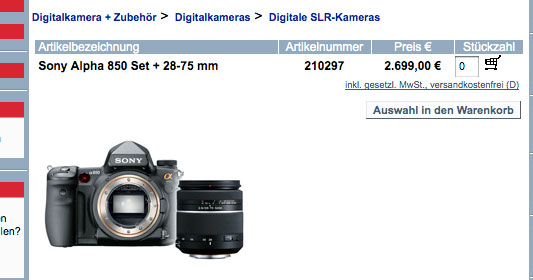
This is a screen grab from Fotobrenner.de in Germany who have the body only offered for €1999.00 and the kit with SAM 28-75mm f/2.8 new lens for €2699.00. As listed that makes the body about 10% more expensive than the current street price of the Alpha 900 – indicating either that the A850 prices are RRP and will rapidly fall, or that the A900 is about to get a price hike. They offer the A900 for €2499.00 and that would – pro rata – make the UK street price for the A850 about £1599. Please note: though the 28-75mm picture is authentic, the body shown has the AF switch set to C – just like the Sony shots of the A900 issued to dealers. Maybe they would do this for all packshots for some reason, maybe it was chance – more likely. It would be unlikely to happen again for the 850 shot so I reckon this is shopped.
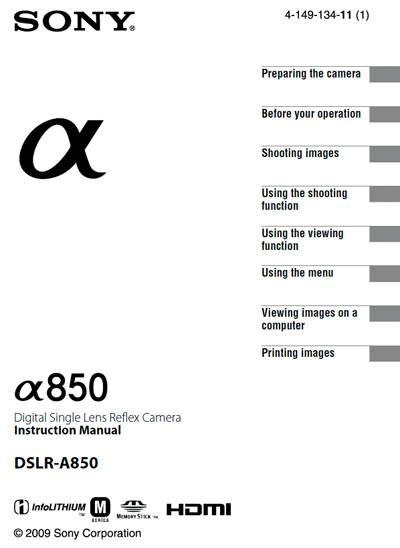
Specifications have been revealed in full, due to the placing of the GB (British) instruction manual PDF on the Sony South-East Asia official website as an accessible download:
http://www.css.ap.sony.com/consumer/hkmc/index.aspx?usr=p&c=en
H_K_F, a member of a forum in the region, reported on Dyxum.com during Saturday August 1st that members of his group had downloaded the file. The result was a bit of a feeding frenzy, with news of the PDF document propagating across forums rapidly, slowing the download speed down. The document was been pulled from the Sony server after return to work on Monday so the link will not work until it is reinstated (Editor’s revision of this post after this happened). NB: it’s amazing how few visitors try clicking the image of the front cover, above, to see what they get 🙂
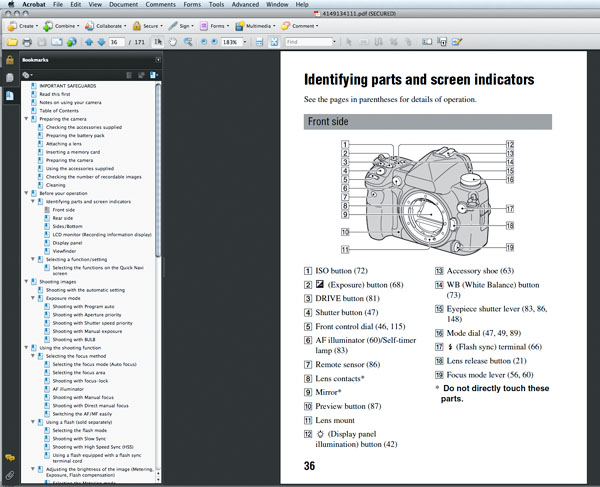
The Alpha 900 uses twin BIONZ processors to achieve 5fps. It also uses, as far as is known, Apical’s proprietary IRIDIX processor to handle the DRO, DRO+ Auto and Manual image optimisation. IRIDIX is still stated by Apical to be limited to 16 megapixels of still image data. The twin BIONZ operate separately in the Alpha 900. Each processor pipelines works in turn, and if one is occupied for too long (perhaps due to card writing preventing the buffer from being refreshed at the output end) a data flow controller will use the other. They do not operate in strict alternation, but in ‘first out, first in’ priority for the image data.
The IRIDIX twin processors presumably work differently on the raw data leaving the BIONZ, in order to handle 24 megapixels. DRO+ certainly slows down operation, and is one way to make sure you don’t get a full 5fps – another way is to enable high ISO noise reduction, and shoot at high ISO (DRO is disabled at high ISO, a possible indication that the IRIDIX is being used for NR, which is another of its functions as described by Apical). It is not a coincidence that DRO is only active below the high ISO NR threshold, and High ISO NR is only available above. The two are mutually exclusive and both slow down image processing by a similar amount.
The Alpha 850, however, achieves 3fps using a single BIONZ or so it is rumoured* – and it does have DRO, and DRO+. Perhaps this means a new method is used for both DRO and DRO+ (which are Sony terminology, not Apical’s tradename) just the same way that Nikon have used both Apical and home-grown image optimising methods, and called them all the same thing. If this is so, then a new Noise Reduction stage may also be used, causing less of a chicane in the race to get the image to the finishing post. And if a new NR process is used, Alpha owners will be anxious to see the high ISO results, and the quality of JPEG conversion in-camera. Certainly, 3fps points to a new variation of the Alpha 900 BIONZ even though the physical unit is known to be the same circuit assembly.
*If this rumour did not exist, I would assume the A850 was just an A900 with a fixed viewfinder mask in place of the adjustable one (cutting out a major manual calibration step in manufacture), and firmware changes.
Whatever the case, they have optimised up the transfer of images to the CF card, and it can not be long before an Alpha 950 appears. Why?
The Alpha 900 can officially (according to the manual) only shoot 12 raw frames consecutively before the shooting rate slows (5fps versus 3fps is not quantified). The Alpha 850 – a cheaper body – can shoot 16 raw. All the capacities are increased:
RAW 16 images (900 – 12)
cRAW 18 images (900 – 12)
RAW & JPEG 12 images (900 – 10)
cRAW & JPEG 12 images (900 – 10)
Extra fine 34 images (900 – 11)
Fine/Standard 384 images/593 images (900 – 105/285)
While RAW shows a worthwhile increase, JPEG improvement is off the chart (another reason I suspect it’s the Apical/Sony bit which handled post-processing, DRO, NR and JPEG conversion which has been upgraded). The Alpha 850 manages THREE TIMES the number of Extra Fine JPEGs, it’s a mere (official) 11 with the A900, and almost four times the number of Standard. Of course, the UDMA 300X Sony CF card now used to measure this was not around when the Alpha 900 was launched, and no mention of it is made in the 900 manual. It gets its own credit in the A850 manual.
Added August 4th: The Alpha 900 tested today with a SanDisk Ducati Edition Extreme IV 4GB manages 14 RAW, 34 Extra Fine at 5fps and 18 RAW, apparently unlimited Xfine at 3fps. Assuming the Sony UDMA 300X is at least equal to the SanDisk Ducati, either these figures are all insignicant – or there are minor changes associated with using a single BIONZ or some modifications to image processing – or card write speeds depend on filesize (block allocation size on the card influences this). Otherwise we would expect to see a much higher figure for Xfine JPEGs and an unlimited figure for Fine/Standard. The anomalies between figures, the non-proportional changes, will have to wait until the A850 appears for an explanation. I realise that I had my Ducati 4GB before I got the A900, as well – 300X UDMA was around in September 2008 if not from Sony.
The second difference between A900 and A850 is that the optical prism shows 98% of the frame, not 100%, but does so at exactly the same 0.74X magnification and with the same 20mm eyepoint. It also accepts exactly the same focusing screens. Money has almost certainly been saved by using a different optical configuration (not an expensive condensor lens) and no fine-tuning of the 98% view frame position. The result should be a very slightly less bright and low-distortion viewfinder, which will be accurately to within 2% of the frame area instead of perfect.
Apart from this, it is exactly the same as an Alpha 900. It weigh the same 850g body only, takes the same battery, shoots the same 880 images per charge, has the same dimensions and is made of the same materials.
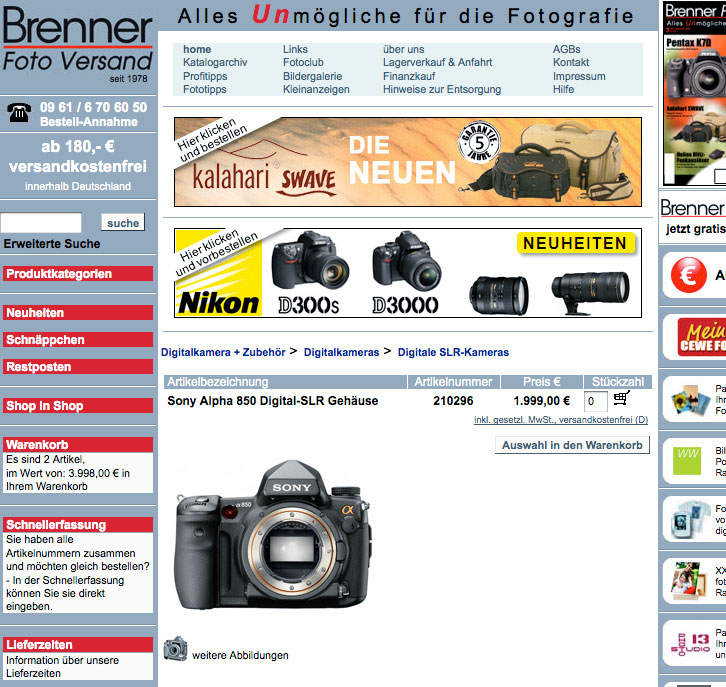
The Alpha 850 PDF manual has sufficient edits and pagination changes to appear genuine, though it might be an early revision. It does not include the HVL-F20AM flashgun, even to the extent of not listing it as a wireless flash controller (its main function with the Alpha 900). This could mean that the Alpha 850 requires the HVL-F58AM to handle wireless flash from an external commander, just as the Alpha 700 does – but without the benefit of a built-in flash to do the basic job. The listing of the Remote Commander as an optional extra is one of the most plausible edits, but the exactly identical weight is confusing.
If one BIONZ processor has been removed, what has replaced the weight?
Here’s my hope – they took away one of the two back-to-back BIONZ circuits, and used the space to install an improved DSP for Noise Reduction, DRO and JPEG conversion. I hope that the A850 is not just a cut-down A900 but will trade sequence shooting speed (the early stage of data processing) for image quality. It will be followed, I think, by an Alpha 950 retaining or bettering the 5fps of the A900 and the continuous frame count of the A850 – along with as yet unknown image quality benefits to bring the full-frame Alpha right up to the level of Nikon’s implementation of the same sensor.
Along with the 500 and 550 – specifications as yet unrevealed – the camera is due for launch any day now (Aug/Sept) and on August 17th this warranty form appeared on Sony Switzerland website:
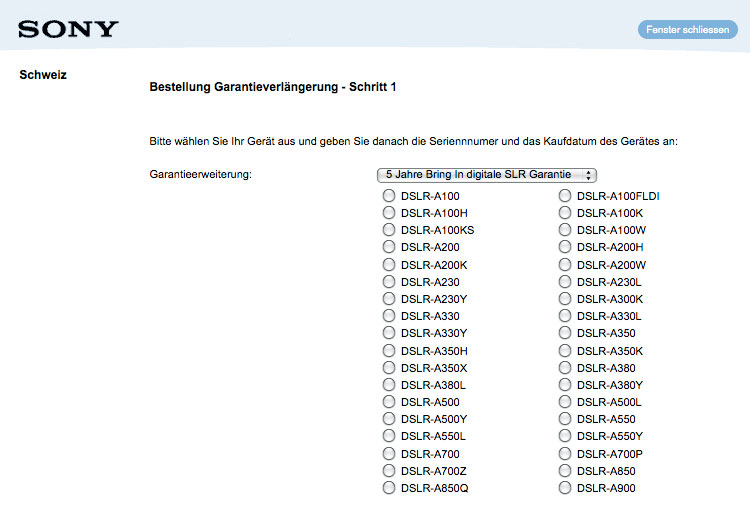
– David Kilpatrick

I have been waiting for years for SONY to put out a camera that will get my juices flowing. The a900 and a850 aren’t doing it! What do you have to do to get through to these guys? Most of us do not need 24+ Mega pixel files to print out 12 X 18 inch photos. SONY just launched the a550 camera, but the friggin thing doesn’t have a sync connector for studio lighting, or my tried and true METZ flashes. Are these people brain dead? At least they had enough sense NOT to put video in the thing. I need a Full Frame 12 – 15 MP digital camera that will take my MINOLTA lenses that are perfectly good, and would also be willing to invest in CZ lenses as well. But for the love of God, PLEASE give us a camera that will work in a studio, that we don’t have to go and invest in some sort of SUPER COMPUTER just to handle the large files. I have been an extremely loyal MINOLTA/SONY customer, but I have to say that I am totally PISSED OFF with the latest offerings from SONY. I NEVER thought I would utter these words, but I am starting to look at the CANON and NIKON lines of cameras. SONY, SMARTEN UP! You are losing us, your most loyal supporters. ARE YOU LISTENING? DO YOU CARE?
According my tests Sony 900 write speed (Lexar 8GB UDMA CF) is about 35MB/s. It is one RAW per second. Buffer capacity is 12 RAW files (420MB). If I capture 5 fps then I could capture actually 14 files because in that 2.3 seconds A900 write 2 (2.3) files in card. In Lo speed mode A900 captured 16 RAWs.
If A850/A900 shutter speed is 3fps, then to feel bufer with the same size 4 second is necessary and you could capture 12+4=16 RAW files.
In addition if these specification is true then A950 seems to be pretty close… or A900 firmware updates, to reach D3x IQ. I hope for firmware. Actually it is possible, that there is nothing removed, just defective A900 with cut-down firmware and different painting goes as A850 🙂